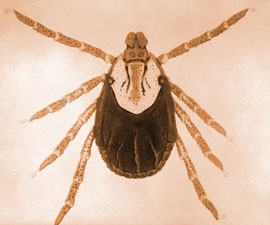Cronkite News has moved to a new home at cronkitenews.azpbs.org. Use this site to search archives from 2011 to May 2015. You can search the new site for current stories.
Rise of Rocky Mountain Spotted Fever has officials urging caution outdoors
PHOENIX – Reported Arizona cases of a potentially fatal disease spread by ticks have increased steadily over the past decade and spiked within the last two years. With temperatures warming, state and federal officials say those heading into the outdoors should be aware of the danger.
Rocky Mountain Spotted Fever is an infection that in Arizona is spread primarily by the common brown dog tick, which is common in higher elevations. The ticks often attach to dogs and can then move over to people.
Will Humble, director of the state Department of Health Services, said Arizonans need to manage their pets in the outdoors to keep the disease from spreading.
“If everyone used tick collars on their dogs, I think we’d have a lot fewer cases,” Humble said. “People may not realize that if they take their Phoenix dog to the high mountain they need to use a tick collar.”
Rocky Mountain Spotted Fever first appeared on the department’s radar in 2002. Since then, the number of reported cases in the state has steadily increased, with 23 cases reported in 2009 and 52 cases in 2011. There was one known death in 2009 and five known deaths in 2011, according to the state health department.
Most cases have been in eastern Arizona, but Humble said there are now cases being reported in southern Arizona.
“We are starting to see more cases in more parts of the state,” he said.
Representatives from the Centers for Disease Control and Prevention and Arizona Department of Health Services held a three-day workshop in Chandler in mid-February to educate public health officials, animal control officers and environmental health specialists on Rocky Mountain Spotted Fever and give tips on prevention.
A couple days after that workshop, the state health department sponsored a meeting on the disease in cooperation with American Indian tribal leaders.
Some of the areas in Arizona most affected by the disease have been on American Indian reservations, where there are fewer resources available to eradicate ticks and control free-roaming animals, said Jennifer McQuiston, the epidemiology activity lead for the Rickettsial Zoonoses Branch of the Centers for Disease Control and Prevention.
Most cases occur between spring and fall, but Arizona’s mild winters allow tickets to survive year-round in many areas.
“Arizona is unique in the sense that we have such a long outdoor season,” Humble said. “It starts earlier and ends later.”
Michael Acoba, epidemiology program manager for the Pima County Health Department, said the one case that was reported in the county last year has officials now conducting “environmental surveillance,” such as collecting ticks near cities and towns and testing them for the disease.
“We’ve informed our county medical providers about the disease and have put a stronger emphasis on trying to control stray dogs,” he said.
Symptoms of Rocky Mountain Spotted Fever initially are similar to those of a severe case of the flu, which makes it difficult for doctors to differentiate it from other diseases, the CDC’s McQuiston.
Characteristic symptoms in the first few days include fever, severe headache, nausea and muscle pain.
A couple days after those flu-like symptoms appear, some people will develop a spotted rash that begins on the ankles and wrists and spreads to the middle of the body.
“We recommend you don’t wait for that rash,” McQuiston said. “Early treatment is key to surviving this disease. If antibiotics are started within the first five days after infection occurs, most people survive.”
Keeping ticks away is the surest prevention. Officials suggest wearing light-colored clothing when hiking or camping to make spotting ticks easier, as well as wearing long-sleeved shirts and tucking pants into socks so there is less exposed skin for ticks to attach to.
People living in areas with dense vegetation should trim back plants and treat their yards with tick-targeting insect repellent.
“If you don’t take those simple precautions, you may be putting your family at risk,” Humble said.








